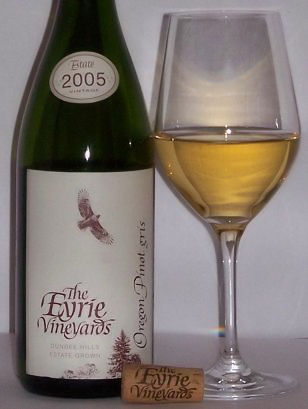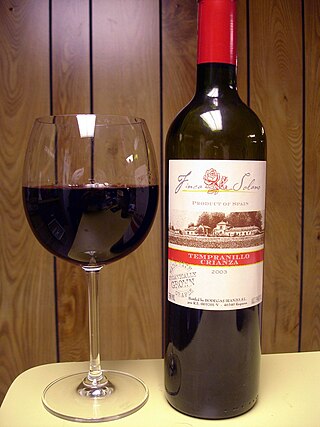
A grape is a fruit, botanically a berry, of the deciduous woody vines of the flowering plant genus Vitis. Grapes are a non-climacteric type of fruit, generally occurring in clusters.

Wine is an alcoholic drink made from fermented fruit. Yeast consumes the sugar in the fruits and converts it to ethanol and carbon dioxide, releasing heat in the process. Though wine can be made from a variety of fruit crops such as plum, cherry, pomegranate, blueberry, currant and elderberry, it is most often made from grapes, and the term "wine" generally refers to grape wine when used without a qualifier.

Flushing is to become markedly red in the face and often other areas of the skin, from various physiological conditions. Flushing is generally distinguished from blushing, since blushing is psychosomatic, milder, generally restricted to the face, cheeks or ears, and generally assumed to reflect emotional stress, such as embarrassment, anger, or romantic stimulation. Flushing is also a cardinal symptom of carcinoid syndrome—the syndrome that results from hormones being secreted into systemic circulation.

Sulfites or sulphites are compounds that contain the sulfite ion, SO2−
3. The sulfite ion is the conjugate base of bisulfite. Although its acid is elusive, its salts are widely used.

White wine is a wine that is fermented without skin contact. The colour can be straw-yellow, yellow-green, or yellow-gold. It is produced by the alcoholic fermentation of the non-coloured pulp of grapes, which may have a skin of any colour. White wine has existed for at least 4,000 years.
Food intolerance is a detrimental reaction, often delayed, to a food, beverage, food additive, or compound found in foods that produces symptoms in one or more body organs and systems, but generally refers to reactions other than food allergy. Food hypersensitivity is used to refer broadly to both food intolerances and food allergies.

Wine labels are important sources of information for consumers since they tell the type and origin of the wine. The label is often the only resource a buyer has for evaluating the wine before purchasing it. Certain information is ordinarily included in the wine label, such as the country of origin, quality, type of wine, alcoholic degree, producer, bottler, or importer. In addition to these national labeling requirements producers may include their web site address and a QR Code with vintage specific information.

Scombroid food poisoning, also known as simply scombroid, is a foodborne illness that typically results from eating spoiled fish. Symptoms may include flushed skin, sweating, headache, itchiness, blurred vision, abdominal cramps and diarrhea. Onset of symptoms is typically 10 to 60 minutes after eating and can last for up to two days. Rarely, breathing problems, difficulty swallowing, redness of the mouth, or an irregular heartbeat may occur.

The health effects of wine are mainly determined by its active ingredient – alcohol. Preliminary studies found that drinking small quantities of wine, particularly of red wine, may be associated with a decreased risk of cardiovascular diseases, cognitive decline, stroke, diabetes mellitus, metabolic syndrome, and early death. Other studies found no such effects.

Wine has been produced in the United States since the 1500s, with the first widespread production beginning in New Mexico in 1628. Today, wine production is undertaken in all fifty states, with California producing 84 percent of all US wine. The North American continent is home to several native species of grape, including Vitis labrusca, Vitis riparia, Vitis rotundifolia, and Vitis vulpina, but the wine-making industry is based almost entirely on the cultivation of the European Vitis vinifera, which was introduced by European settlers. With more than 1,100,000 acres (4,500 km2) under vine, the United States is the fourth-largest wine producing country in the world, after Italy, Spain, and France.

Organic wine is wine made from grapes grown in accordance with the principles of organic farming, which excludes the use of artificial chemical fertilizers, pesticides, fungicides, and herbicides.
Wine laws are legislation regulating various aspects of production and sales of wine. The purpose of wine laws includes combating wine fraud, by means of regulated protected designations of origin, labelling practices and classification of wine, as well as regulating allowed additives and procedures in winemaking and viticulture. Legislation affecting all kinds of alcohol beverages, such as the legal drinking age and licensing practices related to distribution and sales, are usually not considered wine laws.
This glossary of winemaking terms lists some of terms and definitions involved in making wine, fruit wine, and mead.

The color of wine is one of the most easily recognizable characteristics of wines. Color is also an element in wine tasting since heavy wines generally have a deeper color. The accessory traditionally used to judge the wine color was the tastevin, a shallow cup allowing one to see the color of the liquid in the dim light of a cellar. The color is an element in the classification of wines.
Alcohol-induced respiratory reactions, also termed alcohol-induced asthma and alcohol-induced respiratory symptoms, are increasingly recognized as a pathological bronchoconstriction response to the consumption of alcohol that afflicts many people with a "classical" form of asthma, the airway constriction disease evoked by the inhalation of allergens. Alcohol-induced respiratory reactions reflect the operation of different and often racially related mechanisms that differ from those of classical, allergen-induced asthma.

Alcohol intolerance is due to a genetic polymorphism of the aldehyde dehydrogenase enzyme, which is responsible for the metabolism of acetaldehyde. This polymorphism is most often reported in patients of East Asian descent. Alcohol intolerance may also be an associated side effect of certain drugs such as disulfiram, metronidazole, or nilutamide. Skin flushing and nasal congestion are the most common symptoms of intolerance after alcohol ingestion. It may also be characterized as intolerance causing hangover symptoms similar to the "disulfiram-like reaction" of aldehyde dehydrogenase deficiency or chronic fatigue syndrome. Severe pain after drinking alcohol may indicate a more serious underlying condition.
Histamine intolerance is a presumed set of adverse reactions to ingested histamine in food. The mainstream theory accepts that there may exist adverse reactions to ingested histamine, but does not recognize histamine intolerance as a separate condition that can be diagnosed. There is a common suspicion that ingested histamine in persons with deficiencies in the enzymes that metabolize histamine may be responsible for various non-specific health complaints, which some individuals categorize as histamine intolerance, still, histamine intolerance is not recognized as an explicit medical condition with that name in the International Classification of Diseases (ICD) Edition 11, or any previous edition. The scientific proof that supports the idea that eating food containing histamine can cause health problems is currently limited and not consistent.

Wine preservatives are used to preserve the quality and shelf life of bottled wine without affecting its taste. Specifically, they are used to prevent oxidation and bacterial spoilage by inhibiting microbial activity.
The topic of sulfite food and beverage additives covers the application of sulfites in food chemistry. "Sulfite" is jargon that encompasses a variety of materials that are commonly used as preservatives or food additive in the production of diverse foods and beverages. Although sulfite salts are relatively nontoxic, their use has led to controversy, resulting in extensive regulations. Sulfites are a source of sulfur dioxide (SO2), a bactericide.
Histamine is an organic compound that primarily functions in service of the human body's immune responses as well as for the regulation of many physiological functions. Since their discovery in 1910, histamines have been known to trigger inflammatory responses such as itching as part of an immune response to foreign pathogens; for example, mosquito bites or allergens. It is released in granular form by mast cells, a type of white blood cell in connective tissues close to the site of interaction. Upon releasing, it increases the permeability of the blood capillaries for white blood cells and other proteins to enter in order to eliminate the foreign pathogens. The highest concentrations in mammalian tissue occur in the skin, intestines and lungs, sites where most symptoms of allergic responses are felt.










